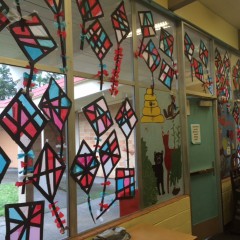Last  week I had 42 students in my classroom.
week I had 42 students in my classroom.
The teacher next door called in sick; so did the teacher down the hall. Unfortunately, there were no available substitutes. We solved the dilemma by dividing the students from the two teacher-less classrooms among four other, nearby classrooms.
The result was six classes of students crammed into four classrooms.
The problem, besides the fact that our classrooms were extremely overcrowded and under-furnished, is that teachers within a grade-level team aren’t exactly at the same place in the curriculum. Thus, it wasn’t feasibly for any of us to simply push ahead with what we had planned for the day. I ended up doing an easy-to-prepare craft activity. (See figure A)
The kids loved it but I didn’t. I can’t stand wasted time and there was a lot of it. Basically we had close to 200 students doing busy-work for most of a day. That’s a lot of wasted time.
Like many states, Washington has a teacher shortage. And the leading edge of that shortage is the substitute pool. Those substitutes who have been looking for full-time employment now have it, and the remaining subs are usually booked days in advance.
The underlying problem is that there just aren’t as many people going into education as there used to be. The reasons behind this problem are legion. But it essentially boils down to the fact that teaching just isn’t the attractive career choice it once was.
I’m not exactly sure how we solve that problem in the long-term, but it’ll probably involve money.
But in the meantime, we’ve got a crisis on our hands. Like it or not, teachers can’t always be in their classrooms. They get sick, their spouses get sick, their kids get sick, their parents get sick, they have meetings, they have professional development and sometimes they just take the day off. Most teachers average about ten days out of the classroom each year, and right now the substitute pool just isn’t deep enough.
One way to solve the problem is to make it easier for retired teachers to work as substitutes. Many schools – like mine – have a recently retired teacher who’s not quite ready to hang it up entirely and becomes the “house sub.” We have Colleen. Colleen knows the faculty, knows the kids and knows the routine. She’s the perfect sub.
The problem is, Colleen can’t work as many days as we want her. That’s because there’s a policy restricting the amount of time retired teachers can work without compromising their pension benefits.
The good news is that there’s a bill in Olympia to address this. HB 1737 will let the Colleens in our state work as a substitute for up to 630 hours per school year without losing their pension.
Will it solve the problem? No. But it’ll help. It’ll let us use recently retired teachers as substitutes until we get through the current substitute crisis.
And it’ll keep me from having 42 students in my classroom.
I had someone who had been in the Navy who decided she might be interested in being a substitute for our district. She went to the one-day training for substitutes. The speaker explained briefly about district policies regarding things like bullying or reporting abuse and directed the attendees to links on the district website where they could read more. Then the prospective substitutes were supposed to sign a paper saying they understood the district policies and would abide by them.
The kicker for my friend was that if there was any problem concerning any of the policies, the district would not stand by the substitute. The substitute was entirely liable. She said she couldn’t put herself at risk that way. “And besides, the Navy gave us similar trainings, but they spent a full day on each of them!”
We may find we have fewer and fewer people signing up to be substitutes too, not just classroom teachers.
This is a simple move that can help a ton. I worry, though, that the sub shortage and the falling numbers of people entering teacher prep programs are the signs of what is to come for public ed.
They are a sign of what’s to come. It isn’t good.